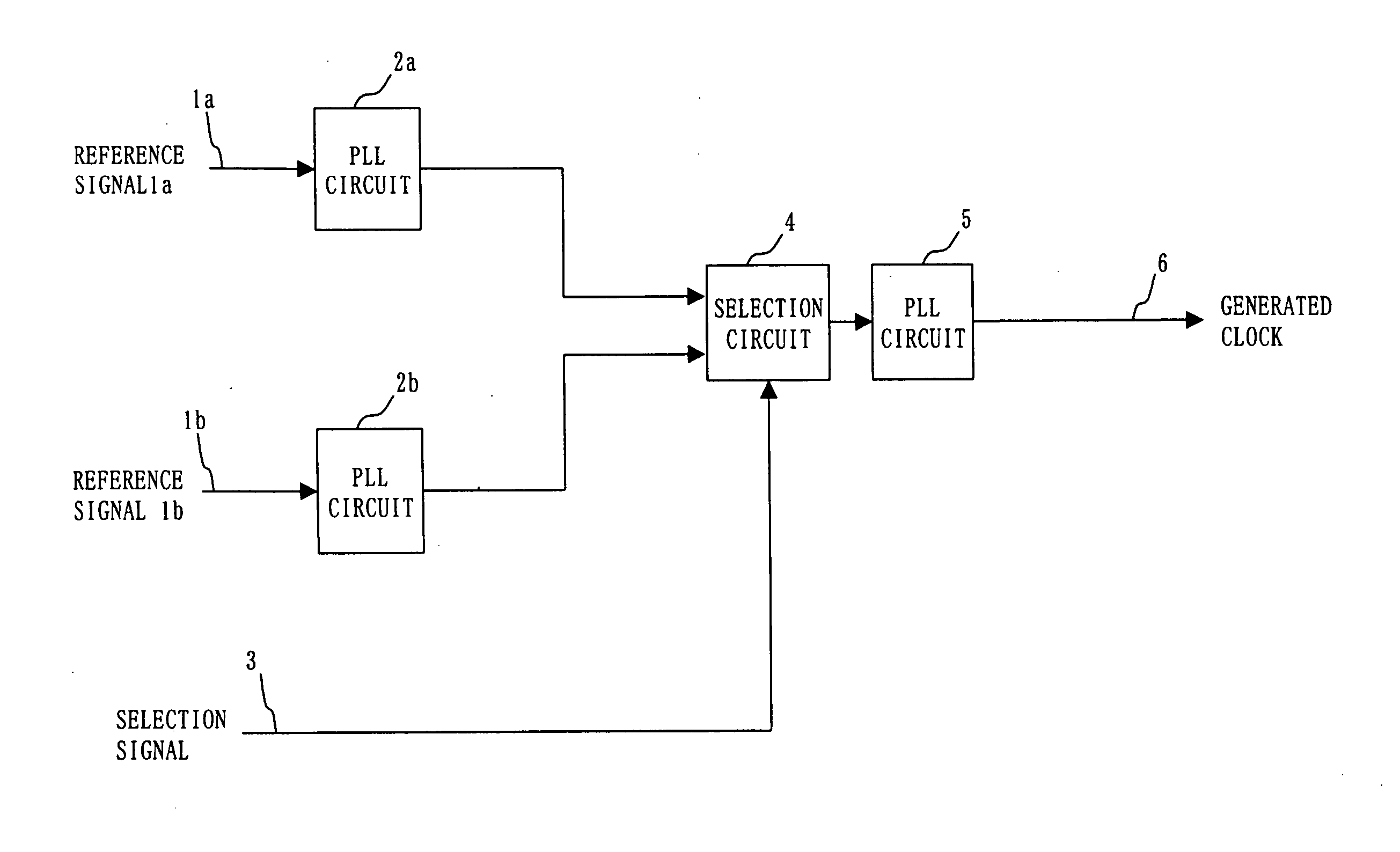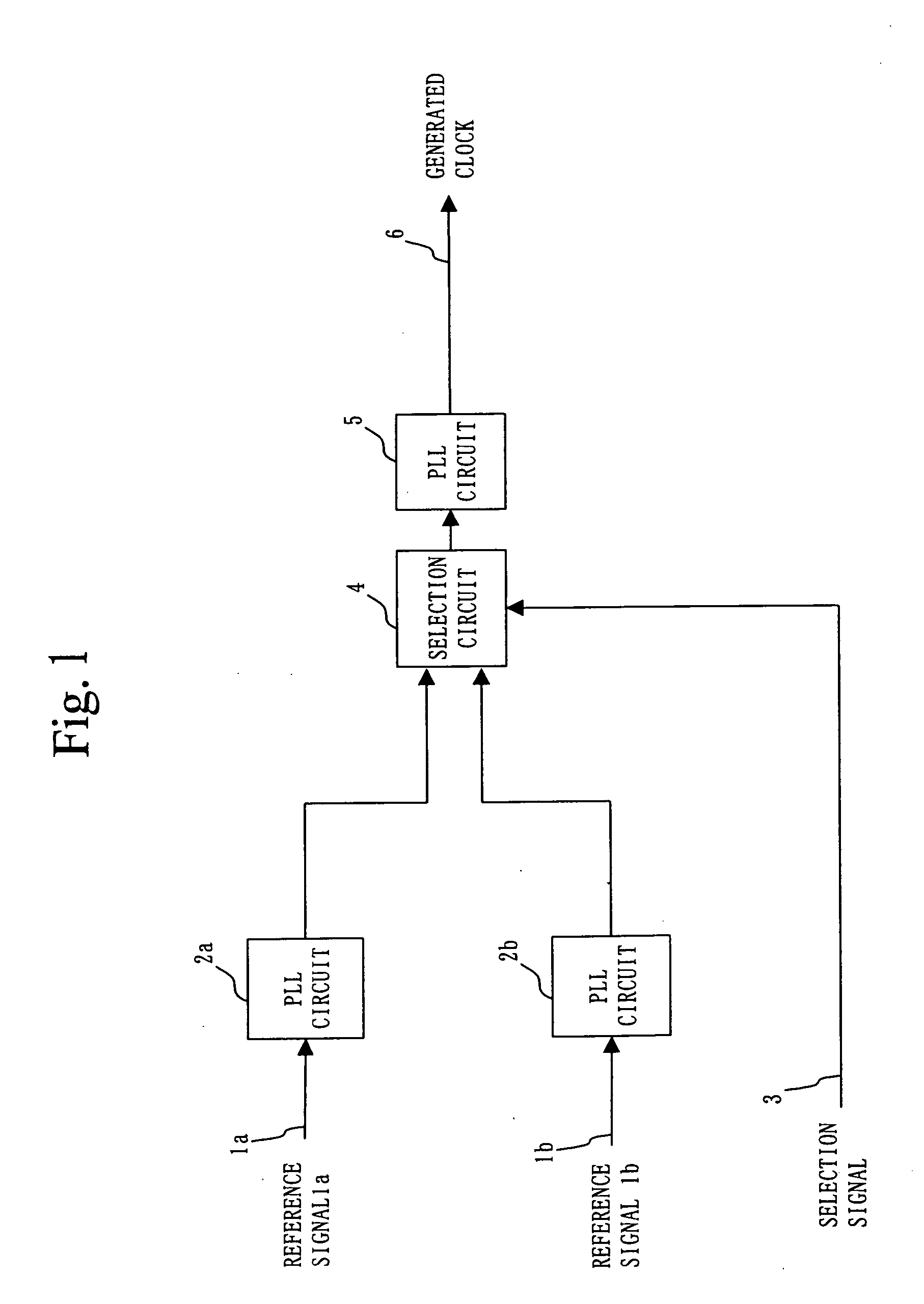Clock generating circuit
a clock generation and clock technology, applied in the direction of generating/distributing signals, pulse automatic control, pulse technique, etc., can solve the problems of large fluctuation of the generated clock b>6/b>, enhancing filter precision performance, and difficult integration of low-pass filters
- Summary
- Abstract
- Description
- Claims
- Application Information
AI Technical Summary
Benefits of technology
Problems solved by technology
Method used
Image
Examples
embodiment 1
[0033]
[0034] Hereinafter, a first embodiment is discussed with reference to FIG. 1. With referring to FIG. 1, a reference numeral 1 denotes a reference signal, a reference numeral 2 denotes a PLL circuit, a reference numeral 3 denotes a selection signal, a reference numeral 4 denotes a selection circuit, a reference numeral 5 denotes a PLL circuit, and a reference numeral 6 denotes a generated clock. FIG. 2 shows the waveform of each element in FIG. 1.
[0035] As shown in FIG. 1, the reference signals 1 are inputted, respectively, to the PLL circuits 2. More specifically, a reference signal 1a is inputted to a PLL circuit 2a, and a reference signal 1b is inputted to a PLL circuit 2b. The PLL circuits 2a and 2b output primary clocks that are synchronized, respectively, with the reference signals 1a and 1b inputted.
[0036] Then, the selection circuit 4 selects one of the primary clocks that are synchronized with the reference signals outputted from the PLL circuits 2, respectively, bas...
embodiment 2
[0044]
[0045] A second embodiment is now discussed with reference to the drawings. With referring to FIG. 3, a reference numeral 1 denotes a reference signal, a reference numeral 2 denotes a PLL circuit (former stage), a reference numeral 3 denotes a selection signal, a reference numeral 4 denotes a selection circuit, a reference numeral 5 denotes a PLL circuit (latter stage), a reference numeral 6 denotes a generated clock, a reference numeral 7 denotes a phase control circuit, a reference numeral 8 denotes a phase comparator circuit, and a reference numeral 9 denotes a control circuit.
[0046] According to the second embodiment, the phase control circuits 7 are provided, respectively, at the outputs of the PLL circuits 2 receiving the reference signals 1, so that the phase of the primary clock outputted from the phase control circuit 7 through the PLL circuit 2 corresponding to the reference signal 1 selected in the selection circuit 4 based on the selection signal 3 and the phase o...
embodiment 3
[0048]
[0049] According to a third embodiment, the phase control circuit 7 discussed in the second embodiment is implemented by a ring counter and a selection circuit.
[0050] With referring to FIG. 4, a reference numeral 1 denotes a reference signal, a reference numeral 2 denotes a PLL circuit (former stage), a reference numeral 7 denotes a phase control circuit, a reference numeral 10 denotes flip-flops, a reference numeral 11 denotes a NOR circuit, a reference numeral 12 denotes a selection circuit, a reference numeral 13 denotes a control signal, and a reference numeral 14 denotes an output of the phase control circuit. FIG. 5 shows the waveform of each element in FIG. 4.
[0051] The primary clock outputted from the PLL circuit 2 operates a ring counter that is configured with flip-flops 10 and the NOR circuit 11. As shown in FIG. 5, outputs from a flip-flop 10a˜a flip-flop 10y are multi-phase signals depending upon the number of the stages in the ring counter. Selecting one of the...
PUM
 Login to View More
Login to View More Abstract
Description
Claims
Application Information
 Login to View More
Login to View More - R&D
- Intellectual Property
- Life Sciences
- Materials
- Tech Scout
- Unparalleled Data Quality
- Higher Quality Content
- 60% Fewer Hallucinations
Browse by: Latest US Patents, China's latest patents, Technical Efficacy Thesaurus, Application Domain, Technology Topic, Popular Technical Reports.
© 2025 PatSnap. All rights reserved.Legal|Privacy policy|Modern Slavery Act Transparency Statement|Sitemap|About US| Contact US: help@patsnap.com



